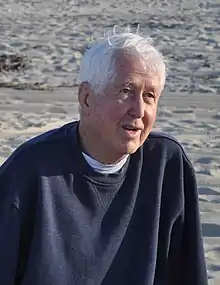Peter D. Welch | |
|---|---|
 Peter D. Welch (2012) | |
| Education |
|
| Occupation(s) | Scientist and researcher |
Peter D. Welch is a scientist and researcher in the area of computer simulation, as well as applied mathematics, applied statistics, and computer science. A former IBM researcher, he is best known for his work with Welch's method to reduce signal noise.
Education
Welch attended University of Chicago. He received his M.S. in Mathematics from the University of Wisconsin (1951), M.S. in Physics from New Mexico State University (1956) and Ph.D. in mathematical statistics from Columbia University (1963).[1][2]
Career
Welch joined IBM Research at the Thomas J. Watson Research Center in Yorktown Heights, New York,[3] where he conducted research and development for over three decades.[4][5] At IBM Research he worked in the areas of speech recognition, spectral estimation, queueing theory, seismic signal processing, fast Fourier methodology, pattern recognition, computer and communication system performance modeling, simulation output analysis, and graphics system design.[6]
Welch played a role in promoting simulation as a rigorous discipline during his service as the Simulation Department Area Editor of Operations Research (1983-1987). Welch's paper on the "use of fast Fourier transform for the estimation of power spectra" or Welch's method, has been cited over 5,000 times and remains widely used to reduce noise caused by imperfect and finite data.[7][8][9]
Awards
Welch received the Institute for Operations Research and Management Sciences (INFORMS) Simulation Society "Distinguished Service Award" in 2010[10] and its "Lifetime Professional Achievement Award" in 2013.[11] The INFORMS Lifetime Professional Achievement Award cites Welch's 62-year career marked by "contributions of fundamental importance not only in the field of computer simulation but also in the broader fields of applied mathematics, applied statistics, computer science." Since the mid-1970s, states INFORMS, "Peter has made groundbreaking contributions to the theory and practice of computer simulation, to the dissemination of knowledge in that field, and to the development of simulation-related software systems."[11]
References
- ↑ "Peter D. Welch, Ph.D. | Computer Simulation Archive". d.lib.ncsu.edu. Retrieved 2020-08-19.
- ↑ "Adjunct and part-time visiting faculty Bios". www.columbia.edu. Retrieved 2020-08-19.
- ↑ "The IBM Watson Laboratory at Columbia University". www.columbia.edu. Retrieved 2020-08-19.
- ↑ Welch, Peter D. (1964). "On a Generalized M/G/1 Queuing Process in Which the First Customer of Each Busy Period Receives Exceptional Service". Operations Research. 12 (5): 736–752. doi:10.1287/opre.12.5.736. ISSN 0030-364X. JSTOR 167778.
- ↑ Cooley, J.W. "The re-discovery of the fast Fourier transform algorithm. (1987)". Mikrochim Acta. 93: 33–45. doi:10.1007/BF01201681. S2CID 30478751.
- ↑ "Adjunct and part-time visiting faculty Bios". www.columbia.edu. Retrieved 2020-08-19.
- ↑ Welch, P. (June 1967). "The use of fast Fourier transform for the estimation of power spectra: A method based on time averaging over short, modified periodograms". IEEE Transactions on Audio and Electroacoustics. 15 (2): 70–73. Bibcode:1967ITAE...15...70W. doi:10.1109/TAU.1967.1161901. ISSN 1558-2582.
- ↑ Dah-Jing Jwo (2021). "Windowing Techniques, the Welch Method for Improvement of Power Spectrum Estimation". Computers, Materials & Continua. 67 (3): 3983–4003. doi:10.32604/cmc.2021.014752. S2CID 234337183. Retrieved 27 September 2021.
- ↑ Shin, Kihong (15 April 2008). Fundamentals of Signal Processing for Sound and Vibration Engineers. Wiley. p. 275. ISBN 9780470725641. Retrieved 27 September 2021.
- ↑ "Awardees - Simulation Society". connect.informs.org. Retrieved 2020-08-19.
- 1 2 "Awardees - Simulation Society". connect.informs.org. Retrieved 2021-05-22.